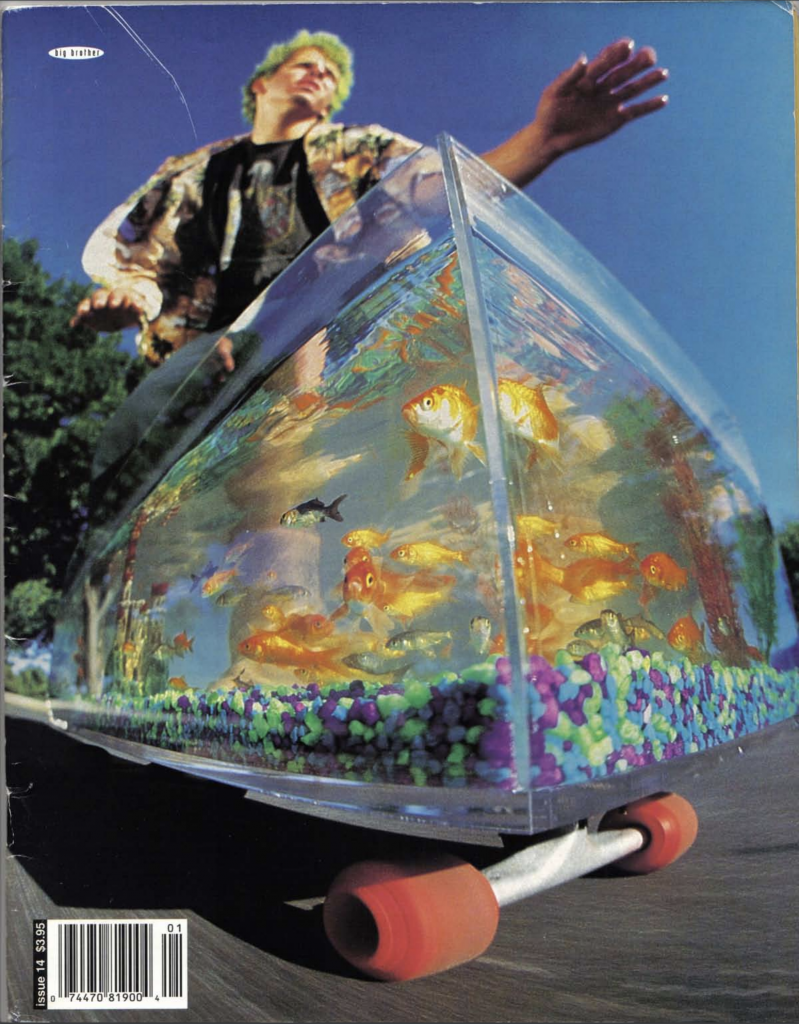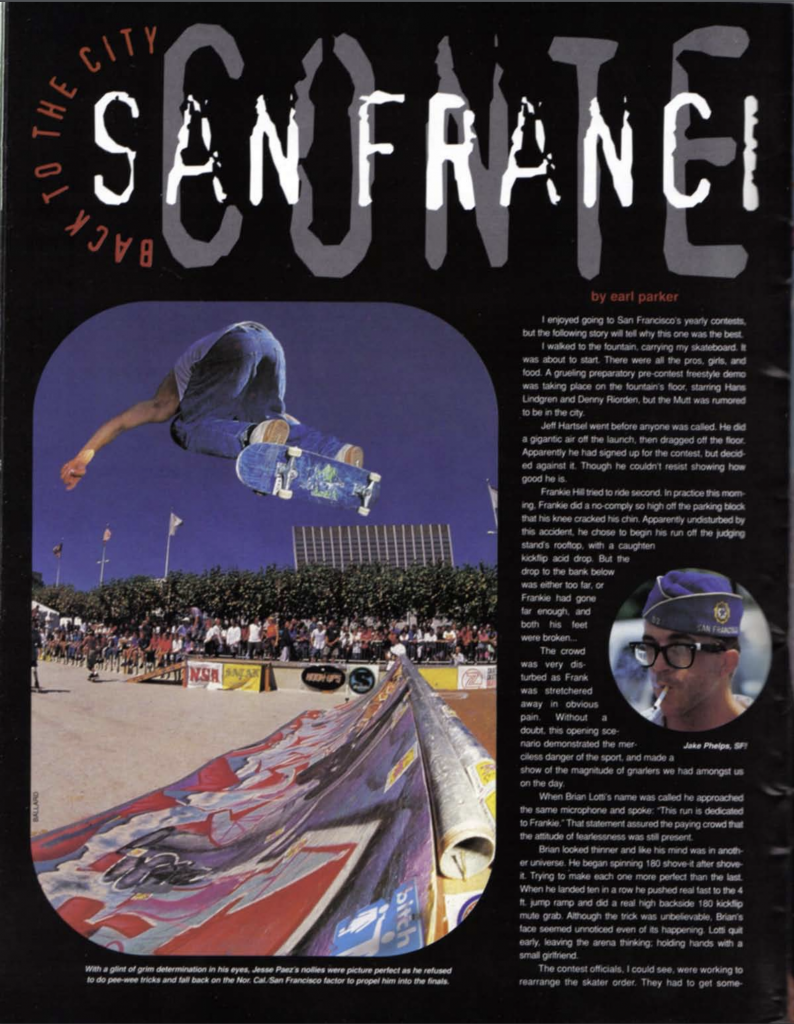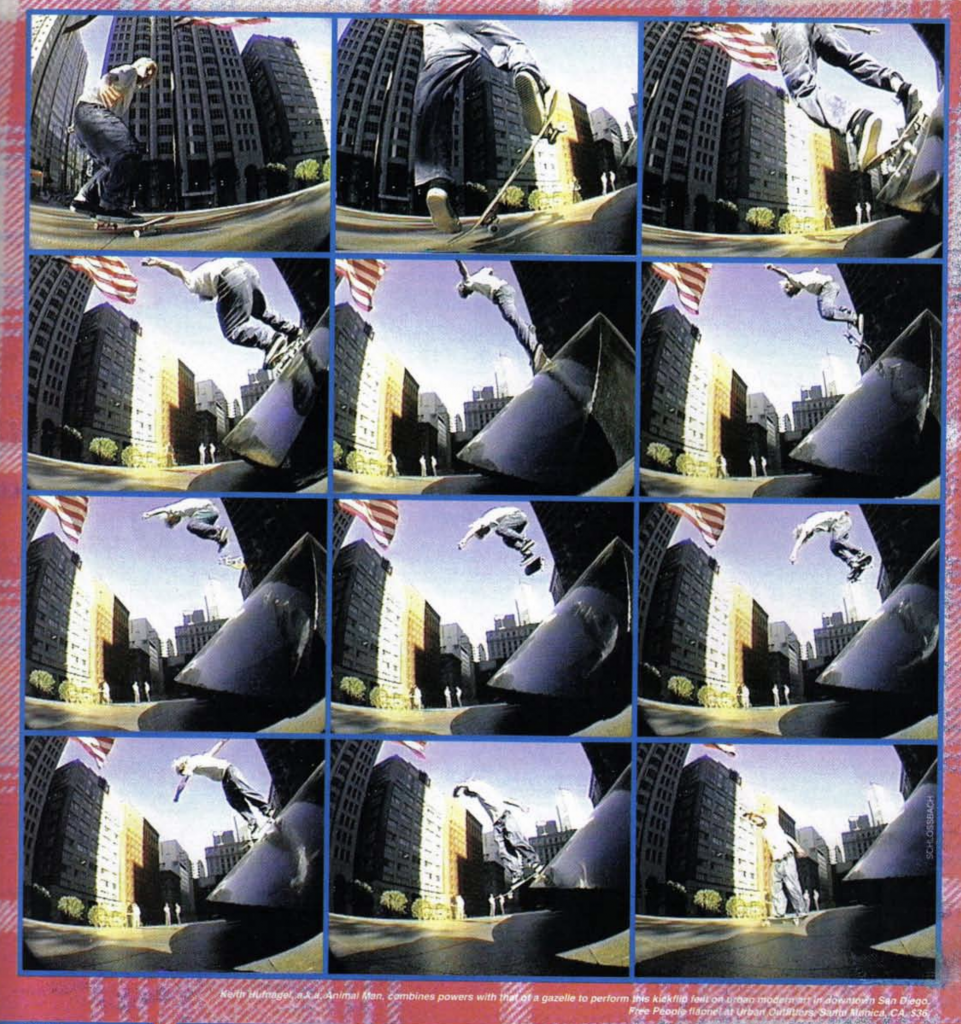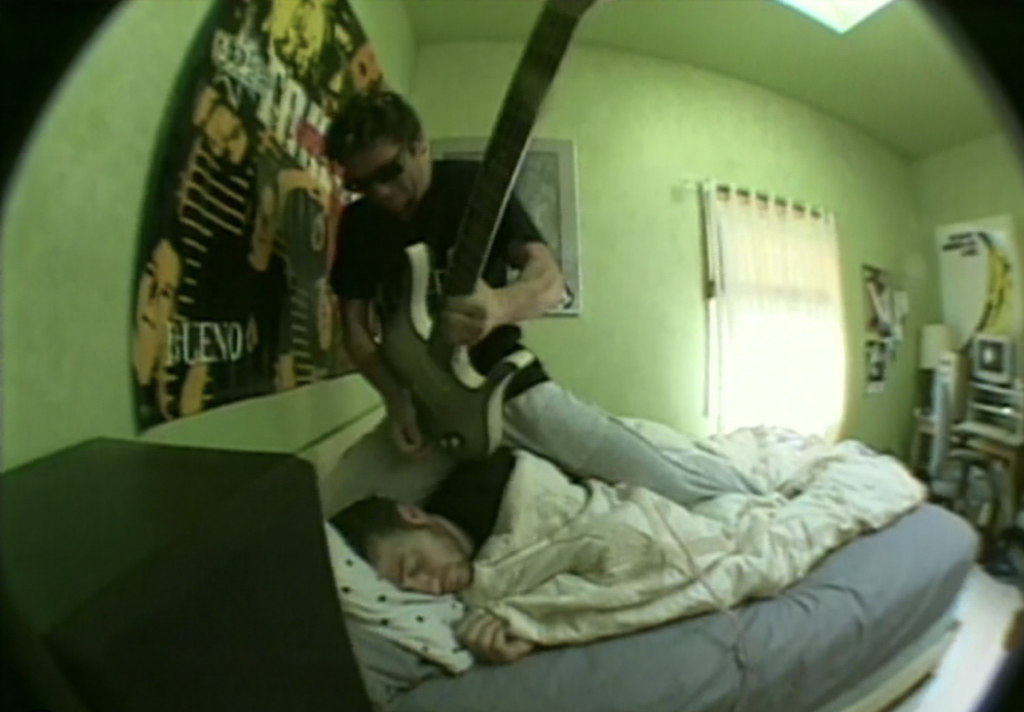To read more about the history of MTV check out this blog here.
Everything changed for MTV in the 90s, they moved away from just the music and started to look at other program offerings for their audiences. Having found success throughout the 1990s with their pioneering reality television series The Real World, MTV had themselves sought to extend the television love affair with imitations of life. Shows such as Road Rules, FANatic and True Life all followed in The Real World’s footsteps, though all failed to achieve the same level of success. But the new millennium gave birth to a unique counter culture that sought to challenge traditional societal constraints.
Everything changed one Sunday in October 2000, when MTV broadcast a 24-minute pilot episode of a new show they had recently picked up. In the pre-credits opening scene, a grinning face peers out from a comically large cannon, resembling Wile E Coyote from Looney Tunes. “Hi, I’m Johnny Knoxville,” he shouts to the camera. “Welcome to Jackass!” These seven words became a catchphrase still recognised some 20+ years later, and marked the beginning of Jackass’s long life in an industry renowned for its fickleness.

In 2001, the world witnessed the rise of the groundbreaking MTV show that would leave an indelible mark on pop culture, one that still has connections to youth culture today. Jackass, masterfully combined skate culture, music, and the phenomenon of self-injury as entertainment, became a true pioneer in the realm of prank videos. Jackass entered the scene at precisely the right moment, vibrantly embodying the spirit of this era. The show launched in the months after the 9/11 attacks and with an attitude that showed no care for life or self injury, it took to looking death and disaster in the face and gave an outlet through careless attitude for youth that stood in stark contrast to the other entertainments at the time. Which had become more sanitised and sterile as a direct response to the attacks. The show embraced anti-establishment sentiments, poking fun at authority while glorifying nonconformity. It resonated with millions of viewers who craved a break from the monotony of everyday life.
In his very early 20s, an aspiring actor/writer named PJ Clapp (aka Jonny Knoxville) filmed a segment for the cult skate magazine ‘Big Brother’ in which, standing in a neat suburban garden that seemed certain to belong to someone’s mom, he sprayed himself with Sabre Red, shocked himself with a 120,000-volt electric taser, and then drove out to the desert to put on a bulletproof vest and shoot himself with a .38 calibre Smith and Wesson at immediate range. The footage, rough and un-reconstituted as a snuff film, is a prototype for the aimless and unavailing self-destructiveness of early Jackass, and an accidental echo of a number of prominent 70s body art performance videos, most notably Chris Burden’s Shoot.




Pages from Big Brother issue 14
At the same time, over in Pennsylvania, a group of skateboarders; Bam Margera, Ryan Dunn, Brandon DiCamillo and Chris Raab – were filming themselves staking and engaging in dangerous and gross-out pranks, under the moniker CKY Crew (short for Camp Kill Yourself). Knoxville, and film director Spike Jonze, came across the CKY Crew videos via the skate scene and swapping of home made VHS tapes, they convinced the CKY Crew to head over to LA and thus the supergroup of all-American delinquents was formed. Headed by Knoxville, it was comprised of staff and associates from Big Brother magazine – one of the other most high-profile people in the Jackass line-up, Steve-O, featured repeatedly in the magazine as a Florida clown.
The show had a distinct look for the time, an unpolished user generated feel using home cameras and equipment accessible by average consumers. Most of the show is shot handheld, giving a homemade and amateur vibe, continuing to hark back to the style of Big Brother and stake culture. This was then personified with the low to the ground camera work and wide shots in public places, adding an element of voyeurism that reflected the underground subculture they were emulating. The creators and stars of the show didn’t have the protection or permission of pre planned shots on sound stages, they often used household or easily accessible items to do their planks, there was a scence of danger in what they were doing and it was danger you too could be in.

Article and images from Big Brother issue 10
Each episode and movie would start with the same format, a wide shot of an overly silly or elaborate stunt and the infamous line “Hi, I’m Johnny Knoxville, and welcome to Jackass”. To this day this line is still parodied and forms part of the pop-cultural zeitgeist, with many modern content creators on social media platforms starting their videos in the same way ““Hi, I’m X, and welcome to X”, most being completely unaware of the origin of their opening lines.
Of the main video elements present in Skate videos (which saw their origins as early as the 1980s) most were born out of equipment limitations; home video cameras had a ‘crunchy’ quality to them created by their lack of colour processing ability, this gives footage a vibrancy which is still seen today with instagram and TikTok filters emulating this analogue effect. Along with the colour limitations, almost all footage is shot in a 4:3 aspect ratio, and recorded on VHS tapes.
The sale of these cameras was aimed at the home video market, as such they needed to be accessible to households as simply as possible. The main visual element that has not stood the test of time and keeps the footage as a product of the early 2000s, is the heavy use of fish eye lenses, this in camera effect enabled viewers to see the wider space while focusing on the main subject. Because skaters move fast through a frame, it’s better to ‘keep it wide’ just in case a skater lands a trick, and you often didn’t get the opportunity to try again. This cinematic style was favoured by many pop punk and stake music artists at the time including Beastie Boys, Blink 182, Sum 41 and CKY, and is present in early 00’s MTV reality shows.

In the early 2000s, music played an integral role in shaping the cultural landscape with the advent of the internet subculture and non mainstream music became easier to fine, listen to and share. Jackass seized this opportunity to further solidify its influence by carefully curating an exhilarating musical backdrop for their pranks and stunts. From punk rock anthems to heavy metal powerhouses, these heart-pumping tracks created an unforgettable auditory experience, leaving a lasting impression on an entire generation. It is arguable that these musical choices impacted the early video sharing micro site Vine and then TikTok who offer pre-made audio to overlay the content created by the user.
A less well remembered staple of the show was the ‘as the public’ elements where the cast would set up a scenario or mock interviews on the street and ask members of the public, this format is now a legitimate show format on its own and a heavy feature in Gen Z online viewing. These content creators vary in style but often are there to embarrass, expose or prank members of the public, or take tone from another MTV 2000s classic Cribs and feature the inside of average peoples homes.
It is impossible to discuss Jackass without addressing its most controversial aspect: the utilisation of self-injury as entertainment. While some condemned the show for glorifying dangerous behaviour, others argued that it embraced the human desire for voyeurism and confrontation with mortality. Jackass sparked heated debates about the boundaries of entertainment, bringing forth discussions about ethics and responsibility in media. The show came under heavy fire from media watchdogs, moral guardians and parents alike for supposedly endorsing dangerous behaviour, much like the WWF (now WWE) did at the same time. However what stood Jackass apart from others, and possibly what keeps it an endearing part of pop culture today is the people who are being injured have all signed up for it, they are friends and it looks like the pranks and injuries are only making their bond stronger.
However, whilst controversial we must acknowledge that the show pushed the boundaries of entertainment by featuring self-injury as a form of humour. With stunts like “The Human Tetherball” and “The Butt X-Ray,” the Jackass crew subjected themselves to physical pain and danger for the sake of entertainment. While some found this shocking, others saw it as a form of liberation, breaking away from the constraints of conventional television and embracing the absurdity of life.
Only 25 episodes of Jackass were filmed, but a year later, Jackass: The Movie smashed into cinemas, bigger, bolder and grosser than anything the stars had done in their television days. The reason for so few TV episodes is a little unclear but pressure on MTV from critics and politicians pushed the show to a later 10pm time slot, then stopping reruns and then ending the show completely. Perhaps the most vocal critic of the show was the Connecticut Senator Joe Lieberman(D), who wrote to MTV in February 2001, urging them to take more responsibility for the programming. This caused friction between the network and the show’s cast and crew, who became frustrated with MTV for bowing to political pressure, and by August 2001, the show had been cancelled. The move to a movie format made it march harder for critics to pull up MTV and Paramount, now it wasn’t freely available on TV it was parents choice if their children watch the pranks and antics of the cast.

To date there are 7 movies, 4 main studio releases and 3 compilation straight to DVD instalments. With low budgets and big gains the movies while not gaining critical acclaim did engage audiences across the world.
Jackass managed to transform the simple act of playing pranks into an art form. Their daring and often absurd pranks inspired countless imitators and gave birth to a global trend of prank videos online. This cultural shift not only permeated the entertainment industry but also influenced the way we interacted with social media platforms, as prank videos became a staple on YouTube, Vine, and TikTok. In fact its almost impossible to watch some of the Jackass clips and not see similarities to vides still being made today, the difference between the two? Not a lot, music tastes and aspect ratio are the only things that set this two media apart.
Pop culture has struggled to recover and find its way in the new internet age, with everyone able to make content and distribute it to the world, its hard to pinpoint what is and isn’t the culture and counter culture of the 2020s. But its impossible to see the new wave of pranksters on platforms like YouTube today, like Logan Paul and Mr Beast without seeing the influences and DNA of the early 00s and Jackass. The fundamental difference between Jackass and the prank culture that we see today is the wholesomeness of the show, which was at its heart about hanging out with your friends, skating and being silly. In the never-ending quest for more views, today’s Jackass-inspired creators often resort to performing increasingly desperate acts in order to make headlines, which are not necessarily gross but morally questionable. And this is where the modern pranksters and public content creators differ the most from the Jackass crew- not in the quality of recording and editing, or the music which as move to a more urban style, but in the push for controversy and viewers.
Would Jackass survive in the modern age of digital dominance? Probably not, but its safe to say without them and the MTV programming of the early 2000s we probably wouldn’t have youth culture we do now.
